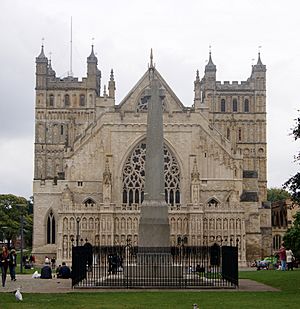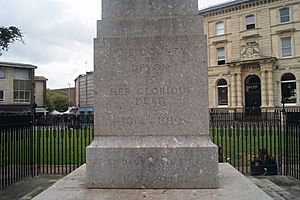Devon County War Memorial facts for kids
Quick facts for kids Devon County War Memorial |
|
|---|---|
| United Kingdom | |
 |
|
| For approximately 11,600 men and women from Devon killed in the First World War | |
| Unveiled | 1921 |
| Location | 50°43′22″N 3°31′54″W / 50.7227094°N 3.5315417°W Cathedral Green, Exeter, Devon
|
| Designed by | Sir Edwin Lutyens |
|
THE COUNTY OF DEVON TO HER GLORIOUS DEAD / 1914–1919 / TE DEUM LAUDAMUS / 1939–1945
|
|
|
Listed Building – Grade II*
|
|
| Official name | Devon County War Memorial and Processional Way |
| Designated | 16 April 2009 |
| Reference no. | 1393228 |
The Devon County War Memorial is a special monument. It remembers the people from Devon who died in the First World War. The memorial was designed by a famous architect named Sir Edwin Lutyens. You can find it on Cathedral Green in Exeter, which is the main town of Devon in south-west England.
This memorial is one of fifteen "War Crosses" that Lutyens designed. They all look quite similar. It's also one of only two such crosses built as a main memorial for a city. At first, people thought about building a cloister (a covered walkway) at Exeter Cathedral to remember the war dead. But this idea didn't happen because there wasn't enough money.
After looking at many ideas, the Devon County War Memorial Committee asked Lutyens to design a War Cross. They chose to put it on the green next to Exeter Cathedral. At the same time, people in Exeter were planning their own city war memorial. But the two groups didn't work together. This led to two separate memorials. The county memorial is by the cathedral. The Exeter City War Memorial is in Northernhay Gardens.
The memorial is a simple cross. It's made from one large piece of granite stone. This stone came from Haytor on Dartmoor. The cross stands just west of the cathedral, lined up with the altar. It has a granite base that sits on three steps. The Prince of Wales officially opened it on 16 May 1921. Later, in the 1970s, the area around it was changed. A special path was made between the memorial and the cathedral. The memorial is a "grade II*" listed building. This means it's a very important historical building. Since 2015, all of Lutyens' memorials in England have been protected.
Why War Memorials Were Built
After the First World War ended, many war memorials were built across Britain. These monuments helped people remember those who had died. One of the most important designers of these memorials was Sir Edwin Lutyens. He was known as a leading English architect of his time. Before the war, Lutyens designed large country houses. One example is Castle Drogo, which is west of Exeter. After the war, he spent a lot of time creating memorials.
Lutyens was one of the main architects for the Imperial War Graves Commission. This group looks after war graves and memorials. He designed many memorials for towns and villages. He also designed memorials in other countries. His most famous design is The Cenotaph in London. This monument is now the main place for national Remembrance Day events.
The Devon County memorial is one of fifteen "War Crosses" designed by Lutyens. He created these between 1920 and 1925. Most of his War Crosses were for small villages. But the Devon County memorial is one of two that became a main city memorial. The other one is the York City War Memorial.
How the Memorial Was Chosen
The first idea for remembering Devon's war dead came in December 1918. This was a month after the war ended. The Dean of Exeter suggested building a cloister at Exeter Cathedral. This cloister might have included a monument. But this plan was stopped in early 1919. There wasn't enough money to build it. Another idea was to build a new part at the Royal Devon and Exeter Hospital.
Some people didn't think building a memorial was a good idea. The head of a local group for soldiers felt the money should help living veterans. He called the idea of a memorial a "useless waste of money." But the Devon County Council still formed a committee. This group was called the County War Memorial Committee. They looked at 23 different ideas, including some from the public.
The committee needed money from public donations. They knew it would be hard to raise a lot of money. This was because communities all over Devon were raising money for their own memorials. But the committee still wanted to build something to remember the county's war dead. So, they decided on a simple but beautiful monument. They hired Lutyens in 1920 and chose his War Cross design.
The committee looked at several places for the memorial. These included Cawsand Beacon on Dartmoor and the Haldon Hills. But they liked the cathedral close in Exeter the most. This spot was chosen so the memorial could be seen from the High Street. With the money they had left, the committee also helped build a memorial in France. This memorial at La Ville-aux-Bois-lès-Pontavert honors the 2nd Battalion of the Devonshire Regiment. This group fought very hard during the Third Battle of the Aisne.
The Devon County War Memorial is one of two main war memorials in Exeter. The other is the Exeter City War Memorial in Northernhay Gardens. Exeter Cathedral also has memorials for the Devonshire Regiment. The city war memorial was planned by a different group. This group was under the Exeter City Council. The city and county groups did not work together well.
Sir James Owen, who led the city group, said the city offered to work together. But the county group refused. Lord Fortescue, who led the county group, said the city went ahead without talking to them. Both groups wanted to design the main memorial for Devon. Neither wanted to give up control. So, two very different memorials were built in Exeter. The city's memorial has a statue of Victory on a large base.
Building and Design of the Memorial
Once the design was chosen, the project went smoothly. The memorial was built on Cathedral Green. It stands just west of the cathedral. It is lined up with the altar inside the church. This means it faces east, along a line from the high altar through the cathedral's nave. It is also northwest of a metal cross. This cross marks where the old church of St Mary Major used to be. That church was taken down in 1971.
The memorial is a 30-foot (about 9-meter) tall granite cross. The stone came from Haytor on Dartmoor. It was carved from one single piece of stone. This was the largest stone Lutyens could find. The cross has a tapering, six-sided shaft. It has chamfered (angled) arms near the top. The arms are not wider than the base.
The cross stands on a three-level base. It also has a rectangular plinth (a block). This plinth sits on three stone steps. This is a common design for Lutyens' war memorials. The middle part of the base has these words carved into it: "THE COUNTY OF DEVON TO HER GLORIOUS DEAD / 1914–1919 / TE DEUM LAUDAMUS / 1939–1945". After it was finished, Lutyens said it was "very simple and a monolith." He added that its careful design meant "labour, care and thought." He believed it "should endure forever."
The memorial was officially opened on 16 May 1921. This was on Whit Monday. The Prince of Wales (who later became King Edward VIII) unveiled it. Lutyens was also there. At the ceremony, Lord Fortescue gave a speech. He said that about 11,600 men and women from Devon had died in the war. He also said that about 63,700 people from Devon had served in the armed forces.
The names of those who died were written in a special book called a roll of honor. Three copies were made. One went to Exeter Cathedral. One was kept by the county council. The third copy was placed by the Prince of Wales in a hollow space at the base of the memorial. The prince's visit caused a lot of excitement. Thousands of people lined the streets to see him. Shops hung banners with welcoming messages. After the unveiling, Edward stayed for ten days to tour the area.
In 1971, archaeologists dug up the western part of Cathedral Green. They found the remains of several Roman buildings, including baths. These ruins were re-buried because there wasn't enough money to protect them. But they were marked as an ancient monument. In 1974, a special path was planned between the memorial and the cathedral. This path was designed by Sir Geoffrey Jellicoe. His design was built after more digging in 1976. It created a square area at the front of the cathedral. From there, wide, shallow steps lead up to a platform at the memorial. This design makes the memorial line up with the altar. It also connects it visually to the cathedral.
In 1979, words were added to the memorial. These words included the dates of the Second World War. In 2006, metal railings were put around the base of the memorial. This was done to stop vandalism and bad behavior. Author Tim Skelton called these railings "an unfortunate addition."
On 16 April 2009, the memorial and its path were given "grade II*" listed building status. This means they are very important for their architecture or history. This status protects them from being torn down or changed without permission. In November 2015, Lutyens' war memorials were called a "national collection." This was part of remembering 100 years since the First World War. All 44 of his freestanding memorials in England were listed or had their listing status checked. Their entries on the National Heritage List for England were updated.




